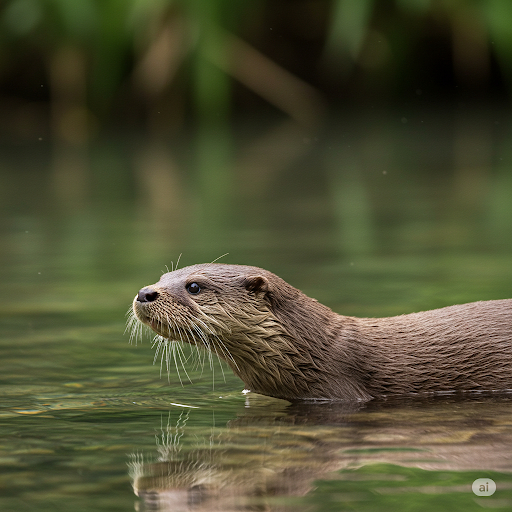Eurasian otter (Lutra lutra) is a semi-aquatic mammal species belonging to the family Mustelidae. It has a wide geographic distribution across various regions of Europe, Asia, and North Africa. This species plays a critical role as a key predator in freshwater ecosystems, helping to maintain ecological balance. In recent years, declines in their populations have been observed due to habitat loss, water pollution, and other human-induced threats. This situation has led to increased scientific research focusing on the ecological importance and conservation needs of the species.
Taxonomy and Morphological Characteristics
Lutra lutra belongs to the subfamily Lutrinae within the Mustelidae family. Its body length ranges from 57 to 95 cm, with a tail length of 35 to 45 cm. Individuals typically weigh between 7 and 12 kilograms. Adapted to a semi-aquatic lifestyle, it has short legs, webbed feet, and dense fur. The fur color is generally shades of brown, with lighter coloration on the throat and chest areas.

Eurasian Otter (Generated by Artificial Intelligence)
Distribution and Habitat
Lutra lutra is found across much of Europe, the western and central regions of Asia, and parts of North Africa. It prefers freshwater ecosystems, particularly rivers, lakes, and wetlands. Key factors influencing its habitat selection include water quality, prey abundance, and the intensity of human activities in the area.
Feeding Habits
The Eurasian otter is a carnivorous species whose feeding habits vary depending on the ecosystem of its habitat. It primarily feeds on fish, but amphibians, crustaceans, and aquatic invertebrates also form part of its diet. Its feeding behavior is influenced by seasonal changes and the availability of prey.

Eurasian Otter and Its Prey (Generated by Artificial Intelligence)
Reproduction and Life Cycle
Lutra lutra can reproduce throughout the year, although reproductive activities mainly peak during spring and summer. The gestation period lasts approximately 60 to 70 days, and females typically give birth to 1 to 4 offspring. The pups are nursed and cared for by their mother for about 10 weeks after birth. Sexual maturity is reached at around 2 to 3 years of age.
Social and Spatial Behavior
Eurasian otters generally live solitary lives. Each individual marks and defends a specific territory. These territories can vary depending on the availability of water resources and habitat structure. Male territories are usually larger than those of females and may sometimes encompass the territories of several females.
Genetic Diversity and Population Structure
Lutra lutra populations may exhibit variations in genetic diversity due to geographic isolation and habitat fragmentation. Genetic studies have identified low genetic diversity and high relatedness in some regions. This situation raises concerns about the long-term sustainability of populations and indicates that conservation strategies should aim to increase genetic diversity.
Health Status and Mortality
The health of Eurasian otters is closely linked to the quality of their habitats and environmental factors. Autopsy studies have revealed health issues in some individuals, including parasitic infections, nutritional disorders, and traumatic injuries. Additionally, human-related factors such as road accidents and water pollution contribute to increased mortality rates.
Impacts of Human Activities
Human activities have various negative effects on Lutra lutra populations. Habitat loss, water pollution, hunting pressure, and roadkill are among the primary threats faced by the species. Moreover, recreational activities and waterway modifications reduce otters’ habitats and negatively affect their reproductive success.
Conservation Status and Strategies
Lutra lutra is classified as “Near Threatened” by the IUCN. It is legally protected in many countries, and various projects are underway to conserve its habitats. Conservation strategies include improving water quality, habitat restoration, hunting bans, and raising public awareness.


